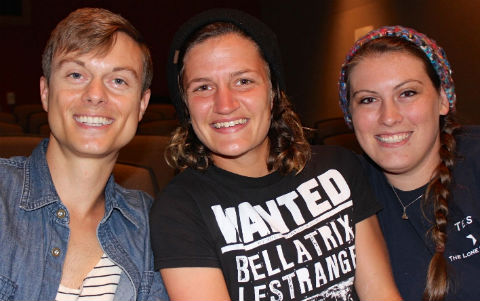New course uncovers ‘shades of gray’ in Little Rock neighborhoods
Days before fall break, Dr. Kristin Mann, associate professor in the UALR Department of History, is standing next to a giant overhead slide outlining a map of vacant homes that cuts a swath across the city.
“And what is this long empty space here?” she asks a crowd of about 30 students, as she points to a light-colored ribbon of space that weaves its way through the map of Little Rock like a ghostly snake.
“Railroad tracks,” correctly responds one of the students.

Mann and her colleagues, Dr. Stacy Moak of the Department of Criminal Justice and Dr. Laura Amrhein of the Department of Art, are using an interdisciplinary approach this semester to engage students enrolled in a new course on neighborhood studies at UALR.
The students are just beginning the second unit of their studies, where they will be required to research a community problem, discover its history and evolution, and, perhaps more importantly, identify a possible solution.
#neighborhoodstudies
In the first unit of the course, the students used Instagram to document, study, and discuss what they saw in the Promise Neighborhood of Little Rock, using the hashtag #neighborhoodstudies.
The neighborhood, bounded by Interstate 630 to the north, Fourche Creek Bottoms to the south, Martin Luther King Drive to the east, and Boyle Park to the west, has seen a long, steady decline in property values over the decades, along with a corresponding increase in crime rates.
A 2011 U.S. Department of Education grant is beginning to turn things around, but it may take a while to undo long-held perceptions of the neighborhood as a threat.
“Perception is reality,” said Mark Webre, a veteran of the Little Rock Parks and Recreation department, and recent guest speaker for the class.
“You can say there’s nothing to be fearful of, but if you go into an area, and it feels unsafe, then people are going to be afraid,” he said. “And they will avoid it.”
“The course does a great job connecting the dots across the disciplines,” said Brandon Snider, a senior history major, whose first unit project focused on the ramifications of building an interstate through the Promise Neighborhood.
Lexus VanPelt, a senior criminal justice major, said the contributions of history and art majors working on her team provided a more holistic viewpoint on her research into a woman advocating for equal pay.
“It’s like the pieces finally fall into place and create a complete picture,” she said.
Rebekah Grissom, also a senior history major, agreed.
“For me, it’s like you learn a broad scope of different kinds of history, but in this class, you see what is happening in a specific town or area. You see the effects of redlining, for example,” she said.
Redlining is a long-held practice of denying or limiting financial services to certain neighborhoods, usually based on race and/or socio-economic status.
Snider said the course is also helping make connections from historical to contemporary times, such as recent news about separate entrances to the same building, one for wealthy residents and one for poor residents of affordable housing units, in a New York City highrise.
“The (discrimination) just wears a different mask; it doesn’t change,” Snider said.
Interdisciplinary studies and community engagement
The Neighborhood Studies course was funded following the provost’s initiative to create and teach across the disciplines, according to Moak. The disciplines for the course include art history, history, and criminal justice.
There is also a strong community service component. The third unit of the course, in fact, will pair students with opportunities to help 22 neighborhood associations in some capacity across the Promise Neighborhood, culminating with a portfolio presentation.
“We’re hoping to get to teach it again next fall and hopefully each fall, so that over time our students can have a measurable effect on the neighborhoods surrounding the university and a deeper appreciation of the multiple lenses through which we can study neighborhoods,” said Mann.
“At the very least, we want to expose the students to new concepts and get them to think about these things differently,” Moak said.
“When you’re more connected, you are more inclined to have that civic engagement,” she said.
“The students have so much technology, they can exist in a virtual world without ever realizing the great divide in sections of our society. My job is to help them to see the gray. If they learn that everything isn’t necessarily black and white, then I’ve done my job.”
The students’ work will also be archived at the UALR Center for Arkansas History and Culture located in the Arkansas Studies Institute and displayed in various locations throughout the Promise Neighborhood.
Keep up with what’s happening; subscribe to UALR Now.